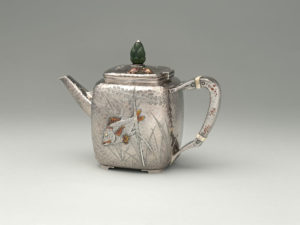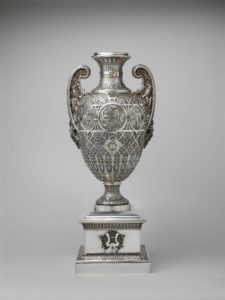The Metropolitan Museum Collection

Silver in the Japanese taste was among the most popular and celebrated work produced at Tiffany’s during these years. Indeed, Tiffany & Co. won the Grand Prize for silverware at the 1878 Paris Exposition Universelle, with the judges citing the originality and virtuosity of the firm’s Japanesque silver. Edward C. Moore (1827-1891), the head of Tiffany’s silver division, assembled a significant collection of Japanese objects to inspire his designers and craftsmen.
Tiffany Silver Urn

To honor the poet and newspaper editor William Cullen Bryant (1794–1878) on his eightieth birthday, a group of his friends commissioned “a commemorative Vase of original design and choice workmanship” that would “embody . . . the lessons of [his] literary and civic career.”
Tiffany silver auctions
Tiffany silver for sale from estate collections and private jewellers including spoons, teapots, bracelets, earrings, rings, watches and table objects.
During the second half of the nineteenth century, Tiffany & Co. rose to prominence as the leading American silversmithing firm and an influential international trendsetter and tastemaker. The 1870s and 1880s witnessed unprecedented innovation and creativity at the firm.
Tiffany Silver Company History
In 1902, after the death of Charles Lewis Tiffany, his son, Louis Comfort Tiffany, became the company's first official design director. In 1905, the Manhattan flagship store was relocated to the corner of 37th Street and Fifth Avenue, where it would remain for 35 years.
In 1919, the company made a revision to the Medal of Honor on behalf of the United States Department of the Navy. This "Tiffany Cross" version was rare because it was awarded only for combat, using the previous design for non-combat awards. In 1942, the Navy established the Tiffany version for non-combat heroism as well but, in August 1942, the Navy subsequently eliminated the Tiffany Cross and the two-medal system.
The company moved its flagship store to its present-day 727 Fifth Avenue building in 1940; the building was designed by Cross & Cross. In 1956, legendary designer Jean Schlumberger joined Tiffany, and Andy Warhol collaborated with the company to create Tiffany holiday cards (circa 1956–1962). In 1968, Lady Bird Johnson, First Lady of the U.S. at the time, commissioned Tiffany to design a White House china-service that featured 90 flowers.
In November 1978, Tiffany & Co. was sold to Disney for about US$104 million in stock. However, in a 1984 Newsweek article, the Fifth Avenue Tiffany store was likened to the Macy's department store during a white sale, due to the high number of inexpensive items on sale; furthermore, customers complained about declining quality and service. In August 1984, Avon sold Tiffany to an investor group led by William R. Chaney for $135.5 million in cash. Tiffany went public again in 1987 and raised about $103.5 million from the sale of 4.5 million shares of common stock.
Due to the 1990–1991 recession in the United States, Tiffany commenced an emphasis upon mass merchandising. A new campaign was launched that stressed how Tiffany could be affordable for all; for example, the company advertised that the price of diamond engagement rings started at $850. “How to Buy a Diamond” brochures were sent to 40,000 people, who called a toll-free number specifically set up to target the broader population. However, to maintain its image as a luxury goods company, high-style images remained on display in Tiffany stores.
Tiffany & Co. trademarked their signature Tiffany Blue color in 1998. Three years later they partnered with Pantone to standardize the color as "1837 Blue".
The History of Silver is a fascinating one to learn more check the Metropolitan Museum article.
____________________________________
“When you click on links to various merchants on this site and make a purchase, this can result in this site earning a commission. Affiliate programs and affiliations include, but are not limited to, the eBay Partner Network.”

























































































































































































































































































